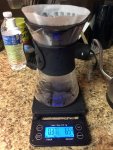Like? I assumed it was just antifreeze for your blood.We like coffee in Finland
The Shaving Cadre
You are using an out of date browser. It may not display this or other websites correctly.
You should upgrade or use an alternative browser.
You should upgrade or use an alternative browser.
The TSC Coffee Shop
- Thread starter BarberDave
- Start date
HMan
Doften Savant
@NurseDave Basically that!
So yesterday was the huge annual whoop-de-doo on a large wine forum site. While I only ordered three bottles of wine, I did get in on this lot of 2 bags each of the following micro lots they call them. Will be roasted today and shipped out Thursday.
Kiandu - Mutheka F.C.S. - Nyeri - AA
Country Kenya
Region Tetu, Nyeri
Farm Various smallholder members of the Mutheka Farmers Cooperative Society
Variety SL-28, SL-34, Ruiru 11, Batian, K7
Altitude 1700 masl
Process Washed
Rich sugar flavor with red grape, citrus fruit and brown sugar; sweet and savory with tart juicy acidity and a heavy mouthfeel.
The Kiandu Coffee Factory is part of the Mutheka Farmer’s Cooperative Society (F.C.S.), which consisting of almost 6,000 active members delivering to seven factories. There is a common average of about 160 coffee trees per farmer, and most farms grow other crops such as maize, beans, and sweet potatoes.
Maputo - Finca Maputo - Rancho Tio Emilio - Hybrid #10
Country Ecuador
Region La Perla, Nanegal, Pichincha
Farm Rancho Tio Emilio
Variety Hybrid #10
Altitude 1350 masl
Process Washed
Tart, sweet and clean with lemon, caramel and praline flavors.
Rancho Tio Emilio is a farm owned by José Gaibor, but farmed by his brother Henry and his wife, Verena, oversee the daily operations of Rancho Tio Emilio, as well as their own land at Maputo and Hakuna Matata where they devote their time, energy, and resources to this passion—coffee.
Together, they are doing everything right when it comes to picking, processing, and drying coffees, and are producing "some of the best coffees I have ever tasted."
This coffee us grown in La Perla, Nanegal, which is in the province of Pichincha, relatively close to the border of Colombia. The area where the farms are located has a very specific microclimate and even though it's relatively low altitude for Ecuador around 1350 meters, humidity is high and a visitor often sees mist covering the coffee fields in the afternoons. It becomes much cooler at night, as well, and the unique combination of characteristics gives this coffee a very special quality.
Eivar Samboni - Los Naranjos Competition #4 - San Agustín - Huila
Country Colombia
Region San Agustín, Huila
Farm Mira Flores
Variety Caturra
Altitude 1700 masl
Process Washed
Sweet with lots of tangy fruit acidity and a sugary mouthfeel; lots of green grape acidity and red grapefruit flavors with caramel and burnt sugar flavors and floral flavors.
Asociación Los Naranjos was founded by a small and tight-knit group of farmers in the area surrounding the town of San Agustín, Huila. Despite the small size of the farms—2.5 hectares or less, on average—and the fact that most producers grow fewer than 12,000 trees, the coffees coming from Los Naranjos have consistently been some of the best and brightest on the cupping table, year after year.
In 2019, our coffee importer and our export partners in San Agustín, co-hosted a cupping contest for the members of the association and this coffee was one of the winning lots featured in the first Los Naranjos Competition.
La Candelilla Micromill - Typica - Honey
Country Costa Rica
Region Tarrazú
Variety Typica
Altitude 1400–1900 masl
Process Honey
Berry flavor with chocolate, caramel, orange and green grape flavors; sweet and soft with balanced fruit acidity and a juicy mouthfeel.
La Candelilla was one of the first micromills in Tarrazú, opening in 2000, and was established and owned by 7 smallholder producers in Tarrazú. This lot is from one of the founders of the mill, Ricardo Hernandez Naranjo, who has been growing coffee for 32 years, and is dedicated to the process, as are many of the producers who utilize La Candelilla.
Kiandu - Mutheka F.C.S. - Nyeri - AA
Country Kenya
Region Tetu, Nyeri
Farm Various smallholder members of the Mutheka Farmers Cooperative Society
Variety SL-28, SL-34, Ruiru 11, Batian, K7
Altitude 1700 masl
Process Washed
Rich sugar flavor with red grape, citrus fruit and brown sugar; sweet and savory with tart juicy acidity and a heavy mouthfeel.
The Kiandu Coffee Factory is part of the Mutheka Farmer’s Cooperative Society (F.C.S.), which consisting of almost 6,000 active members delivering to seven factories. There is a common average of about 160 coffee trees per farmer, and most farms grow other crops such as maize, beans, and sweet potatoes.
Maputo - Finca Maputo - Rancho Tio Emilio - Hybrid #10
Country Ecuador
Region La Perla, Nanegal, Pichincha
Farm Rancho Tio Emilio
Variety Hybrid #10
Altitude 1350 masl
Process Washed
Tart, sweet and clean with lemon, caramel and praline flavors.
Rancho Tio Emilio is a farm owned by José Gaibor, but farmed by his brother Henry and his wife, Verena, oversee the daily operations of Rancho Tio Emilio, as well as their own land at Maputo and Hakuna Matata where they devote their time, energy, and resources to this passion—coffee.
Together, they are doing everything right when it comes to picking, processing, and drying coffees, and are producing "some of the best coffees I have ever tasted."
This coffee us grown in La Perla, Nanegal, which is in the province of Pichincha, relatively close to the border of Colombia. The area where the farms are located has a very specific microclimate and even though it's relatively low altitude for Ecuador around 1350 meters, humidity is high and a visitor often sees mist covering the coffee fields in the afternoons. It becomes much cooler at night, as well, and the unique combination of characteristics gives this coffee a very special quality.
Eivar Samboni - Los Naranjos Competition #4 - San Agustín - Huila
Country Colombia
Region San Agustín, Huila
Farm Mira Flores
Variety Caturra
Altitude 1700 masl
Process Washed
Sweet with lots of tangy fruit acidity and a sugary mouthfeel; lots of green grape acidity and red grapefruit flavors with caramel and burnt sugar flavors and floral flavors.
Asociación Los Naranjos was founded by a small and tight-knit group of farmers in the area surrounding the town of San Agustín, Huila. Despite the small size of the farms—2.5 hectares or less, on average—and the fact that most producers grow fewer than 12,000 trees, the coffees coming from Los Naranjos have consistently been some of the best and brightest on the cupping table, year after year.
In 2019, our coffee importer and our export partners in San Agustín, co-hosted a cupping contest for the members of the association and this coffee was one of the winning lots featured in the first Los Naranjos Competition.
La Candelilla Micromill - Typica - Honey
Country Costa Rica
Region Tarrazú
Variety Typica
Altitude 1400–1900 masl
Process Honey
Berry flavor with chocolate, caramel, orange and green grape flavors; sweet and soft with balanced fruit acidity and a juicy mouthfeel.
La Candelilla was one of the first micromills in Tarrazú, opening in 2000, and was established and owned by 7 smallholder producers in Tarrazú. This lot is from one of the founders of the mill, Ricardo Hernandez Naranjo, who has been growing coffee for 32 years, and is dedicated to the process, as are many of the producers who utilize La Candelilla.
Aaron
0
Enjoy it while it lasts. My caffeine cutoff time kept creeping up earlier and earlier until now it's before I wake up!There's that D word again
Brewed my first batch this afternoon, a lb of Guatemalan.
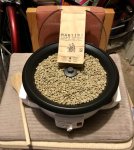
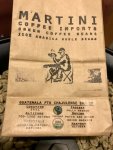
This was my starting temp, a mistake. Next time I'm cranking it up to 240C and dialing back after the "first crack" - that should shorten the roast time..

Here is the finished product. I removed lid and shut off heat at the second crack, which the book tells me is a med-dark roast, which is what I was shooting for. Some of the chaff stuck to the lid, which vented most moisture and smoke. BTW, I didn't need to open the garage door as the smoke was minimal for this degree of roast.
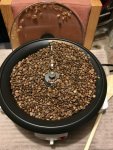
From the roaster I transferred to the strainer, where cool down began while I shook and sifted the beans while blowing away the chaff.

One of the videos I watched used this method to help cool down the beans: shallow bowl floating in cold water. I stirred up the beans a couple of times to bring the hot ones to the surface. I need to get more efficient and not waste 5 minutes between stopping the roast and getting them afloat.
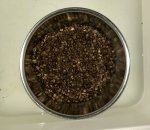
This was second crack and when I shut it down. Boosting the beginning temp may shorten the roast.

I think I'm going to enjoy roasting. This roaster makes it ridiculously easy, and videos I watched here and on youtube explained the process, which really is the same no matter which method you use. I'm thinking I need a burr grinder. The Krups I have dates back to the '80s...


This was my starting temp, a mistake. Next time I'm cranking it up to 240C and dialing back after the "first crack" - that should shorten the roast time..

Here is the finished product. I removed lid and shut off heat at the second crack, which the book tells me is a med-dark roast, which is what I was shooting for. Some of the chaff stuck to the lid, which vented most moisture and smoke. BTW, I didn't need to open the garage door as the smoke was minimal for this degree of roast.

From the roaster I transferred to the strainer, where cool down began while I shook and sifted the beans while blowing away the chaff.

One of the videos I watched used this method to help cool down the beans: shallow bowl floating in cold water. I stirred up the beans a couple of times to bring the hot ones to the surface. I need to get more efficient and not waste 5 minutes between stopping the roast and getting them afloat.

This was second crack and when I shut it down. Boosting the beginning temp may shorten the roast.

I think I'm going to enjoy roasting. This roaster makes it ridiculously easy, and videos I watched here and on youtube explained the process, which really is the same no matter which method you use. I'm thinking I need a burr grinder. The Krups I have dates back to the '80s...
based on Color i'd say that's more of a med to med-light roast but that can still have some good flavor. just less of the roasty notes. I'm curious to see how it tastes for you.
a couple things to note is that once you finish a roast, its a bad idea to try to re-roast the beans darker. flavor is not great and can just taste burnt.
the other is that different varieties of beans will roast slightly different, which is why roasting can be a bit of an art. once you have done a few roasts you will really start to pick up on a lot of the subtleties and that is when the real fun begins!
a couple things to note is that once you finish a roast, its a bad idea to try to re-roast the beans darker. flavor is not great and can just taste burnt.
the other is that different varieties of beans will roast slightly different, which is why roasting can be a bit of an art. once you have done a few roasts you will really start to pick up on a lot of the subtleties and that is when the real fun begins!
Dave in KY
Shave Newbie
@Graybeard57 you did it. I think I want a roaster like that and may give this coffee stuff a whirl...... Down another hole
Yeah, I think I experienced some beginner's luck here. No doubt I'll burn a batch at some point. Maybe I should have waited a couple of more minutes before stopping, but I was concerned about the elapsed time. I have three more individual lbs to roast, and am chomping at the bit to go play with them. Of course, I'll use one bag at a time. This roaster can hold up to 750 gm, so a lb at a time is a cinch for it. Do you think it took so long because it was a lb? Now that I think of it, most videos I saw roasted less per batch, which may explain the extended roast time. I'd love to drink a cup today, but I'm letting the CO2 escape for at least 24 hrs. Kyle, your video was very instructive. Thanks for posting it, you subtle enabler!once you have done a few roasts you will really start to pick up on a lot of the subtleties and that is when the real fun begins!
I look forward to learning this craft. Like one of the videos pointed out, it's a fun hobby and you get great coffee for your efforts. It's a win-win, in my book.I contemplated a roaster like that. Like Kyle it looks more like a light roast to me. It is a fun hobby!
Have you seen @uacowboy 's video? It's not hard and can cost very little. This roaster has good features, though it is pretty low tech compared to what's out there.@Graybeard57 you did it. I think I want a roaster like that and may give this coffee stuff a whirl...... Down another hole
You'll love it Dave. and it'll "save you money"!@Graybeard57 you did it. I think I want a roaster like that and may give this coffee stuff a whirl...... Down another hole
It could be that it was the quantity slowing the process. More mass need more energy to heat it up. Does that have any air blowing through the beans or is it just like a crock-pot with a stirring mechanism? that could be part of it too.Yeah, I think I experienced some beginner's luck here. No doubt I'll burn a batch at some point. Maybe I should have waited a couple of more minutes before stopping, but I was concerned about the elapsed time. I have three more individual lbs to roast, and am chomping at the bit to go play with them. Of course, I'll use one bag at a time. This roaster can hold up to 750 gm, so a lb at a time is a cinch for it. Do you think it took so long because it was a lb? Now that I think of it, most videos I saw roasted less per batch, which may explain the extended roast time. I'd love to drink a cup today, but I'm letting the CO2 escape for at least 24 hrs. Kyle, your video was very instructive. Thanks for posting it, you subtle enabler!
I'd go forward with a couple of smaller batches till you get the process down. then you can play with larger batches a little easier.
Also, i totally roasted a small batch to the point of burnt one time just to see the whole process to that point. Do it once on purpose with a small amount and its easier to avoid with a larger one.
and thank you, you are most welcome!
it'll "save you money"!
For me it actually has. Only hobby to do that so far.
Dave in KY
Shave Newbie
Do what would you say is the pro and cons to this model verses the model Chad has?
Great, now Dave is going to find some model with turbo, auto shut off and a dancing hula girl and we'll all need that one!@Graybeard57 you did it. I think I want a roaster like that and may give this coffee stuff a whirl...... Down another hole
Do what would you say is the pro and cons to this model verses the model Chad has?
Mine has a chaff catcher. So don't have to deal with that part of the process. Which was a big selling point for me.

